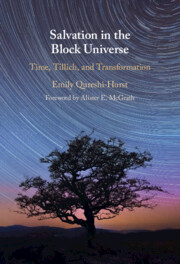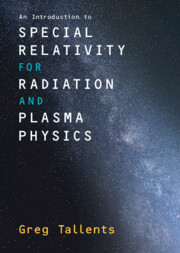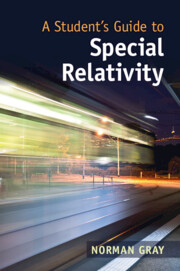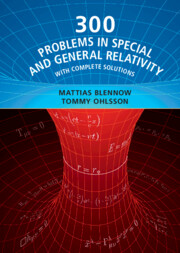30 results
2 - Special Relativity
- from Part I - The Block Universe
-
- Book:
- Salvation in the Block Universe
- Published online:
- 09 January 2025
- Print publication:
- 23 January 2025, pp 42-76
-
- Chapter
- Export citation

Salvation in the Block Universe
- Time, Tillich, and Transformation
-
- Published online:
- 09 January 2025
- Print publication:
- 23 January 2025
1 - Introduction to general relativity 1: Kinematics and Einstein equations
- from Part I - Formalism
-
- Book:
- Introduction to Supergravity and its Applications
- Published online:
- 14 November 2024
- Print publication:
- 21 November 2024, pp 5-17
-
- Chapter
-
- You have access
- Export citation

An Introduction to Gravity
-
- Published online:
- 04 May 2024
- Print publication:
- 11 April 2024
-
- Textbook
- Export citation
7 - Beyond the Schrödinger Equation
-
- Book:
- A Computational Introduction to Quantum Physics
- Published online:
- 24 April 2024
- Print publication:
- 25 April 2024, pp 130-151
-
- Chapter
- Export citation
1 - Newtonian Gravity
-
- Book:
- An Introduction to Gravity
- Published online:
- 04 May 2024
- Print publication:
- 11 April 2024, pp 1-50
-
- Chapter
- Export citation

Special Relativity
-
- Published online:
- 26 June 2023
- Print publication:
- 20 July 2023
-
- Element
- Export citation

An Introduction to Special Relativity for Radiation and Plasma Physics
-
- Published online:
- 10 November 2022
- Print publication:
- 24 November 2022

A Student's Guide to Special Relativity
-
- Published online:
- 26 January 2022
- Print publication:
- 03 February 2022
-
- Textbook
- Export citation

Sidney Coleman's Lectures on Relativity
-
- Published online:
- 23 December 2021
- Print publication:
- 13 January 2022
1 - Special Relativity Theory
-
- Book:
- 300 Problems in Special and General Relativity
- Published online:
- 02 December 2021
- Print publication:
- 09 December 2021, pp 14-42
-
- Chapter
- Export citation
3 - Solutions to Problems
-
- Book:
- 300 Problems in Special and General Relativity
- Published online:
- 02 December 2021
- Print publication:
- 09 December 2021, pp 77-349
-
- Chapter
- Export citation

300 Problems in Special and General Relativity
- With Complete Solutions
-
- Published online:
- 02 December 2021
- Print publication:
- 09 December 2021
Chapter 1 - The Genealogy of Thomas Kuhn’s Metaphysics
- from Part I - Foundational Issues
-
-
- Book:
- Interpreting Kuhn
- Published online:
- 25 June 2021
- Print publication:
- 08 July 2021, pp 9-26
-
- Chapter
- Export citation
Chapter 4 - Principles of Special Relativity
- from Part I - Space and Time in Newtonian Physics and Special Relativity
-
- Book:
- Gravity
- Published online:
- 03 September 2021
- Print publication:
- 24 June 2021, pp 47-76
-
- Chapter
- Export citation
Chapter 1 - Gravitational Physics
- from Part I - Space and Time in Newtonian Physics and Special Relativity
-
- Book:
- Gravity
- Published online:
- 03 September 2021
- Print publication:
- 24 June 2021, pp 3-12
-
- Chapter
- Export citation

Foundations of Modern Physics
-
- Published online:
- 22 April 2021
- Print publication:
- 22 April 2021
4 - Relativity
-
- Book:
- Foundations of Modern Physics
- Published online:
- 22 April 2021
- Print publication:
- 22 April 2021, pp 88-123
-
- Chapter
- Export citation
2 - Relativity
- from Part I
-
- Book:
- Modern Classical Mechanics
- Published online:
- 30 November 2020
- Print publication:
- 10 December 2020, pp 63-118
-
- Chapter
- Export citation
2 - General Relativity
-
- Book:
- Compact Star Physics
- Published online:
- 17 August 2020
- Print publication:
- 27 August 2020, pp 8-37
-
- Chapter
- Export citation

